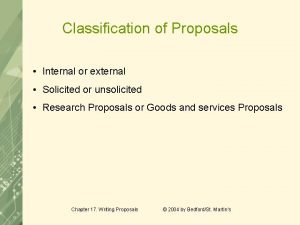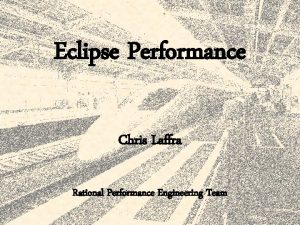CLEPAOICA comments to ALKS draft text Proposals for






- Slides: 6

CLEPA/OICA comments to ALKS draft text Proposals for amendments to document GRVA-05 -07 -Rev. 3 19 February 2020

1 - Harmonize § 8. 2. 1. b) and c) “ 8. 2. 1. b) Deactivation of the system due to: …” or “ 8. 2. 1. c) “Transition demand by the system, due to: …”. 2 - Rearrangement of § 8. 2. 1. point e), f) & g) regarding « Risk of imminent collision » By definition, the ALKS will engage an Emergency Manoeuver every time there is a risk of imminent collision (§ 5. 2. 5. & 5. 3. 1. ). Having a flag for “Emergency Manoeuver” and another flag for “Risk of imminent collision” becomes then useless, because both flags will always be merged behind the same Time Stamp. CLEPA/OICA suggests to: and Delete f) Detected risk of imminent collision and keep only Rename g) Detected end of imminent risk of collision into e) Emergency Manoeuver g) End of Emergency Manoeuver “An emergency manoeuver shall not be terminated, unless the imminent collision risk disappeared or the driver deactivated the system. ” (§ 5. 3. 3. ) Should the driver deactivate the system during an Emergency Manoeuver, this would then be indicated by 2 flags : - one flag for the Deactivation : element b) - one flag for the End of Emergency Manoeuvre : element g) Both flags would share the same timestamp, and appear in chronological order, according to § 8. 3. 2.

3 - Link § 8. 2. 1. point i) « Collision detected » with § 5. 1. 1. CLEPA/OICA fully support the link between “collision detected” in § 8. 2. 1. i) with the “detected collision” of § 5. 1. 1. And then suggests to indicate : i) Involved in a detected collision 4 - Deletion of § 8. 2. 1. point m) « Detected deviation of lane of travel » The ALKS is by definition not authorized to cross the lane markings, even when performing an Emergency Manoeuver (§ 5. 3. 2. ). Should the ALKS vehicle nevertheless cross the lane marking, then this would most probably be due to non detectable markings (missing markings, blinded sensors or sensors perturbed by a dazzling light source…). As a consequence, the ALKS would be “unaware” of such crossing, hence would not “flag” this situation. Note that the ALSK would prevent the vehicle from crossing the lane should it detect such possibility. CLEPA/OICA recommend not adding an entry for “deviation of lane of travel” because the ALKS generally cannot flag it. “it is not possible to indicate that a system fails to detect something by only using this system unsuccessful means”.

5 - Deletion of § 8. 2. 1. point n) to s) regarding demist, wipers, and headlamp status 1 Rapidly changing weather conditions (e. g. rain intensity), could create a lot of entries just for variation of wiper speed. 2 Some countries mandate permanent headlamps even in daytime. (most of the others now mandate Daytime Running Ligths) 3 “Wipers” & “Headlamps” vs. activated ALKS: Ø Possibility 1 : “Wipers ON & headlamps ON” guarantees good front vision but does not fit good daytime conditions. Ø Possibility 2 : “Wipers in AUTO mode & headlamps in AUTO mode” provides good transition when ALKS turns to OFF (while ALKS is active, these features necessarily work in AUTO mode) Wipers and headlamps “AUTO” modes have the same behavior, whether the ALKS is engaged or not. Note: the use of ALKS is dedicated and limited to driving at speeds below 60 km/h, on highway, in a typical situation of Traffic Jam.

6 - § 8. 3. 1 “Software versions relevant to the system” SW N+1 Elements 1 2. . . x Elements x+1 x+2. . . y Proposal: DSSAD does not need to store the identification of the SW for each element. The list of elements can then be retrieved “in addition” to the identification of the SW that was present. Note: Rx. SWIN correctly identifies the SW in case the manufacturer choses this path per § 9. 3. 7 - Modification of § 8. 4. 3 regarding the reference to crash tests As far as the present draft for ALKS is aimed at being published as a UN ECE regulation, CLEPA/OICA would suggest not to refer to crash test procedures other than the ones covered by UN ECE regulations. Should this text for DSSAD be considered separately, CLEPA/OICA would suggest to indicate the fact the alternative national crash test procedures should however be “regulatory” : “The data shall be retrievable even after an impact of a severity level set by UN Regulations Nos. 94, 95 or 137, or other relevant national regulatory crash test procedures. “

8 - Modification of § 8. 4. 4 “Easily readable data” Data should be readable in a technology neutral way: some existing vehicles may provide no OBD port (e. g. Electric Vehicles) as OBD was initially required by regulations for the sake of Internal Combustion Engine emissions). CLEPA/OICA suggest aligning the requirements for DSSAD with those for EDR, as the approaches for data retrieval are quite close. Current text in EDR draft : “Each manufacturer of a motor vehicle equipped with an EDR shall ensure by licensing agreement or other means that a tool(s) is commercially available that is capable of accessing and retrieving the data stored in the EDR that are required by this part. ”











